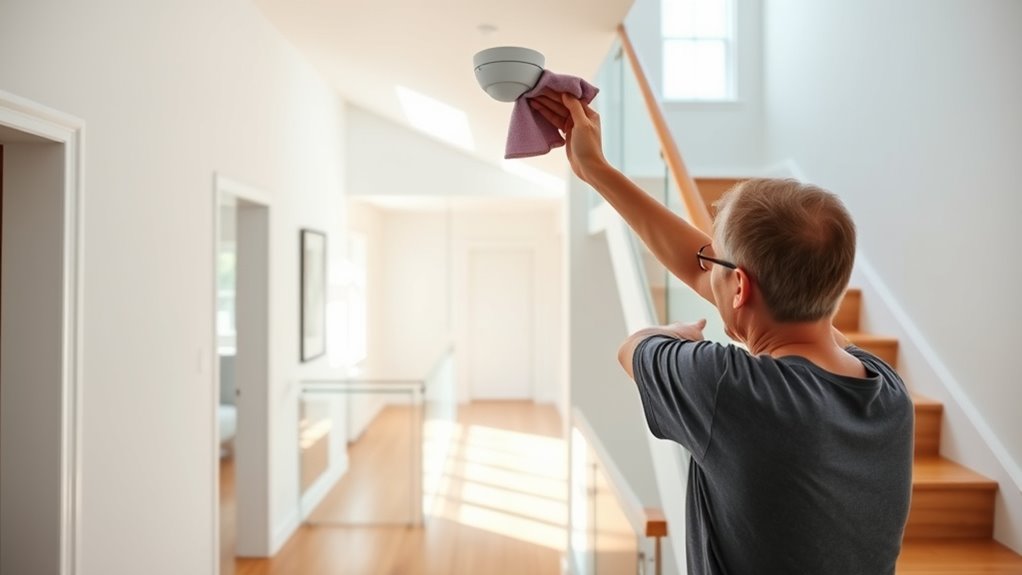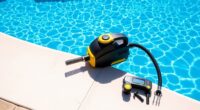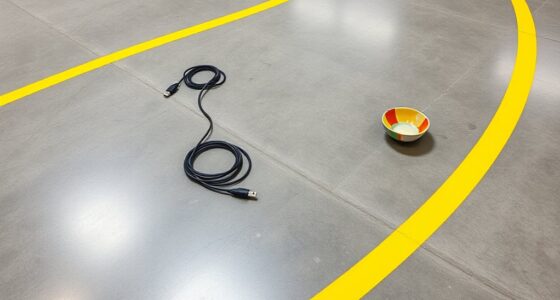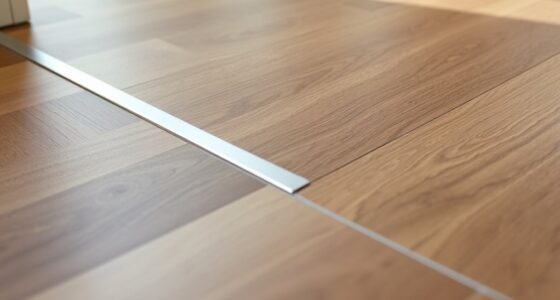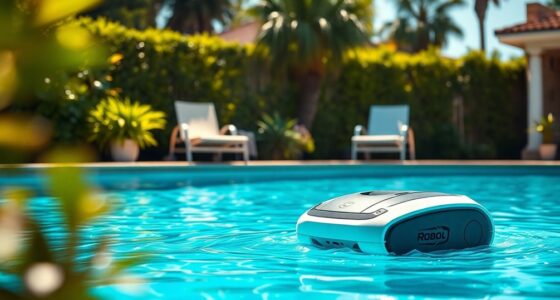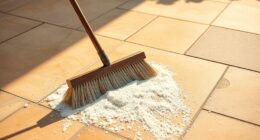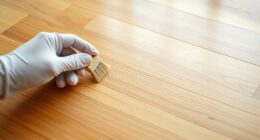To prevent cliff and wall errors in your two-story home, regularly clean your sensors with a soft, dry cloth or gentle brush to remove dust and debris. Avoid harsh chemicals and be gentle around delicate components. Focus on sensors near stairs, ledges, and walls, ensuring they’re properly aligned and free of obstructions. Proper maintenance and calibration are key to reliable performance. Keep going to discover more tips for maintaining your sensors effectively.
Key Takeaways
- Regularly clean sensors near stairs and walls with a soft, dry cloth to prevent false triggers and cliff errors.
- Use gentle brushes or microfiber cloths to remove dust and debris from hard-to-reach sensor surfaces.
- Avoid harsh chemicals; dampen cloths lightly with water for safe cleaning without damaging sensors.
- Recalibrate sensors after cleaning, following manufacturer instructions to maintain detection accuracy.
- Inspect sensors for damage or misalignment periodically and seek professional help for complex repairs.
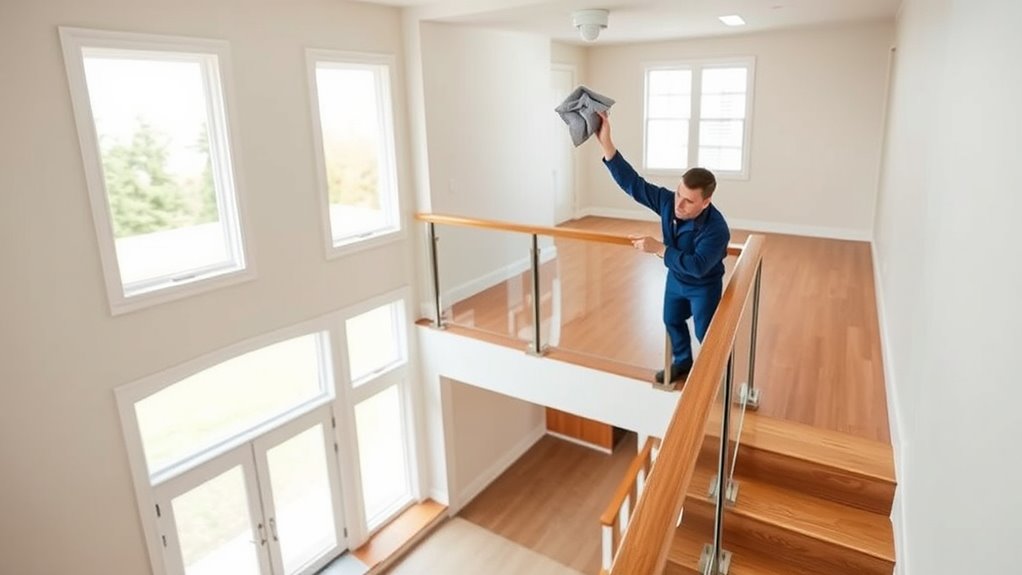
Ever wondered how to keep your home’s sensors working accurately across both floors? Maintaining sensor accuracy in a two-story home can be challenging, especially when dealing with issues like cliff and wall errors that can disrupt your smart systems. These errors often happen because sensors misjudge distances or fail to detect obstacles properly, leading to false triggers or missed detections. Fortunately, regular cleaning and calibration can help prevent these problems, ensuring your sensors operate smoothly and reliably.
Start by understanding that dust, dirt, and debris tend to accumulate on sensor surfaces over time, especially in high-traffic or dusty areas. When sensors become dirty, their ability to detect objects accurately diminishes, which can cause cliff errors—where sensors mistakenly interpret a change in surface level as a drop, like at stairs or edges. Wall errors occur when sensors misread reflections or obstructions, resulting in false alarms or missed detections. To combat this, you need to clean your sensors regularly using a soft, dry cloth or a gentle brush. Avoid harsh chemicals that could damage sensitive components; instead, opt for a microfiber cloth lightly dampened with water if needed. Be gentle but thorough, ensuring you reach all sensor surfaces, including those in hard-to-access spots.
Pay special attention to sensors placed near staircases, ledges, or along walls, as these are most prone to cliff and wall errors. When cleaning, move slowly and deliberately to prevent knocking the sensors out of alignment. For sensors with protective covers or lenses, remove these carefully if possible, and clean underneath to remove any accumulated dust or smudges. Regular inspections can help you spot any signs of damage or misalignment early, so you can adjust or replace sensors before errors become persistent. Additionally, understanding that proper sensor calibration is essential for maintaining accuracy can significantly reduce error occurrences and improve system reliability.
Calibration is equally important. After cleaning, follow your manufacturer’s instructions to recalibrate your sensors if required. Some devices automatically recalibrate after cleaning, but others might need manual adjustments. Ensuring correct calibration helps the sensors interpret their environment accurately, reducing false triggers caused by misreadings. Keep an eye on sensor performance over time—if errors persist despite cleaning, it might indicate underlying issues like misalignment or hardware faults. In such cases, consulting a professional or replacing the faulty sensor can save you headaches down the line.
Frequently Asked Questions
How Often Should Sensors Be Cleaned in Two-Story Homes?
You should clean your sensors every three to six months to guarantee peak performance. Regular cleaning prevents dust, dirt, and debris from interfering with sensor accuracy, especially in two-story homes where dust can settle more quickly on upper levels. Keep an eye on sensor alerts or performance issues, and clean sooner if you notice any irregularities. Consistent maintenance helps avoid errors and keeps your security system running smoothly.
What Tools Are Best for Cleaning High Sensors Safely?
To clean high sensors safely, you should use an extendable microfiber duster or a telescoping pole with a soft brush attachment. For example, in a two-story home, you might attach a microfiber cloth to a broom handle to reach and gently wipe the sensors without risking a fall. Always make certain your tools are stable and avoid using metal or abrasive materials that could damage the sensors.
Can Sensor Cleaning Damage the Home’s Wiring or System?
Sensor cleaning generally won’t damage your home’s wiring or system if you use the right tools and techniques. You should avoid harsh chemicals, excessive moisture, or aggressive scrubbing, which can cause electrical issues or physical damage. Always turn off power before cleaning, and use gentle, non-abrasive materials like microfiber cloths or soft brushes. If you’re unsure, consult a professional to prevent accidental damage and guarantee safety.
Are There Specific Cleaning Products Recommended for Sensors?
Yes, there are specific cleaning products recommended for sensors. You should use a gentle, electronics-safe cleaner or a soft cloth slightly dampened with water. Avoid harsh chemicals, abrasives, or sprays directly onto the sensor. Always turn off the sensor and follow the manufacturer’s instructions. Using the right products helps prevent damage, keeps your sensors functioning correctly, and ensures your home’s safety systems operate smoothly.
How Do I Prevent Future Sensor Errors After Cleaning?
Think of your sensors as delicate dancers on a stage; if you don’t give them proper care, they stumble. After cleaning, you prevent future errors by ensuring sensors stay dry and free of dust. Regularly check their alignment, avoid sudden movements, and keep your home’s environment stable. Replace batteries promptly and perform periodic tests. These steps keep your sensors in perfect harmony, dancing smoothly without missteps.
Conclusion
Regular sensor cleaning in your two-story home isn’t just about maintenance; it’s about preventing surprises that seem almost coincidental—like avoiding wall and cliff errors when you least expect them. When you stay ahead of dust and debris, you create a smoother, more reliable environment. It’s funny how a simple routine can unexpectedly save you from costly mishaps, turning what feels like coincidence into a conscious act of care that keeps your home running seamlessly.
